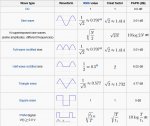Re: 60 Degree DIY Mid Hi
Yes but the AES measurement is calculated from the RMS voltage squared divided by the minimum impedance. So if the load was a resistor the AES and "RMS" power would be the same. Accordingly the AES and RMS ratings are similar. The AES measurement uses one octave of shaped pink noise. I think the RMS test was done a 1KHz ...
Given that the AES is made in free air, its arguable the power handling should be measured in the actual enclosure over the nominal operating band, and referenced to the nominal impedance ... similar to what EAW do - http://eaw.com/docs/6_Technical_Information/StudyHall_and_TechNotes/Power_Handling.pdf
The AES measurement we are talking about uses a peak-to-rms voltage ratio of 2:1, limiting the 12 dB crest factor pink noise to a 6 dB crest factor.
Back in the "olden days" (pre-1984), the "RMS watts" used to test speakers were sine waves (same as used for rating amplifiers) which have a crest factor of 3 dB.
I'm so old that if there is not a reference to AES I still assume a sine wave for "RMS" watts...
Yes but the AES measurement is calculated from the RMS voltage squared divided by the minimum impedance. So if the load was a resistor the AES and "RMS" power would be the same. Accordingly the AES and RMS ratings are similar. The AES measurement uses one octave of shaped pink noise. I think the RMS test was done a 1KHz ...
Given that the AES is made in free air, its arguable the power handling should be measured in the actual enclosure over the nominal operating band, and referenced to the nominal impedance ... similar to what EAW do - http://eaw.com/docs/6_Technical_Information/StudyHall_and_TechNotes/Power_Handling.pdf
Attachments
Last edited:



